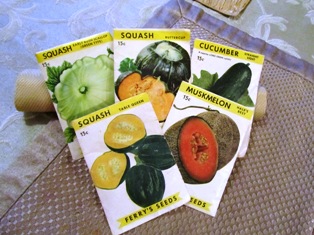Saving and Sharing Seeds

Packets of Ferry’s Seeds imprinted on the reverse with the words, “Packed for season,” and stamped 1958
Saving and sharing seed dates back to thousands of years before our forefathers brought their favorite heirloom seeds from their countries of origin to plant in their American gardens and fields. My grandmother, a frugal Scots-Irish farm woman, taught me by example how to save seed. I was six when I went to live with her in Boone County, Missouri. Our daily chores began before dawn.
She would strain the warm milk my grandfather brought from the barn after he had milked the cows. I was dispatched to the chicken house to collect eggs, sometimes from underneath hens still sitting on them. She would begin cooking the first of three hearty meals for the day.
With the breakfast dishes done, my grandmother and I would tend the vegetable gardens. We would hoe and weed by hand until the sun got high or until Grandma had decided which vegetables she wanted to include in the noonday meal. If her choice included tomatoes or beans, for example, they were gathered in baskets along with produce from her favorite plants from which she would remove and preserve the seeds.
She dried and stored the seed in paper envelopes or bags or glass jars. These she kept for planting in future gardens. The saving and sharing of seed among farmers and gardeners of my grandmother’s era and her ancestors was a traditional practice. Today, the practice continues with organic and home gardeners who share the belief that seed biodiversity must be ensured in keeping with natural evolutionary processes.
Today, commercial seed companies and corporations commonly file patents on seeds they have hybridized or cloned, making it illegal for farmers and gardeners to sell or otherwise distribute the seed. The hybridization produces a particular plant (that may have resistance to certain diseases or pests or display an unusual color, for example) in its first year, but second-generations of such hybrids may not come true. More alarming is the suggestion that reliance on commercial hybridized seed means the loss of thousands of varieties of open-pollinated plants such as those my grandmother grew.
Open-pollinated plants remain true to type and yield when planted from seed collected from the parent plant during the previous year. Some backyard gardeners, farmers, and plant growers today eschew using seed that has been genetically modified. They favor organic heirloom seed and are fueling an enthusiastic grass-roots effort to preserve the practice of saving and sharing seeds.
Tags: clone, heirloom, hybrid, seed savers
 Facebook
Facebook Goodreads
Goodreads LinkedIn
LinkedIn Meera Lester
Meera Lester Twitter
Twitter


